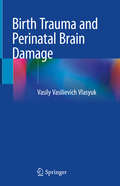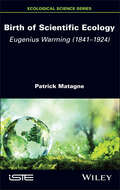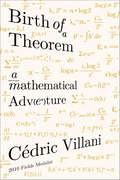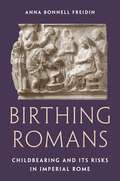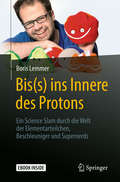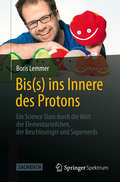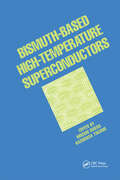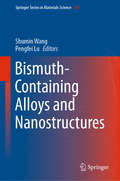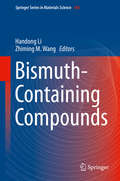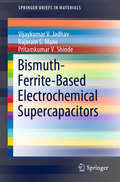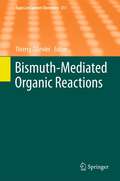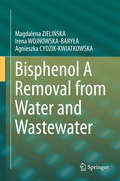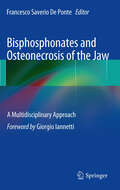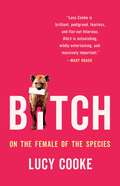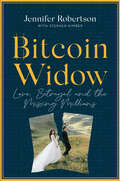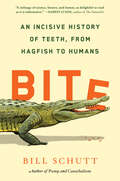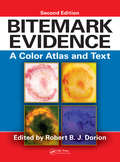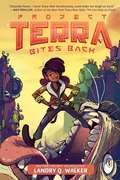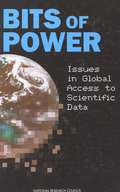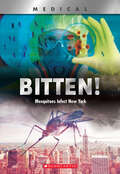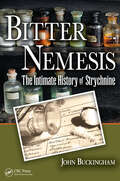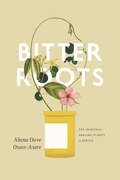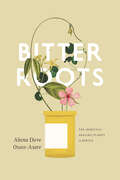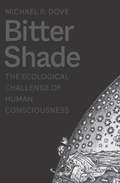- Table View
- List View
Birth Trauma and Perinatal Brain Damage
by Vasily Vasilievich Vlasyuk<p>This book focuses on traumatic birth injuries, predominantly of the skull and brain, as well as hemorrhagic and ischemic disorders of cerebral circulation in fetuses and newborns, providing information on each condition’s classification, incidence, etiology and pathogenesis, pathomorphology, clinic, diagnostics, prognosis, and complications. It discusses the configuration (molding) of the head, venous congestion, displacements of cranial bones, ruptures of the cerebellar tentorium during labor, and the compression of the skull and brain damage caused by obstetric operations and asynclitic insertion of the head, while also describing the importance of the periosteal stagnation of the skull to assess the delivery and explanation of tentorium tears. Intracranial hemorrhages are considered in detail, taking into account the role of the traumatic factor in their occurrence and hypoxic-ischemic brain lesions (periventricular leukomalacia, selective neuronal necrosis, multicystic encephalomalacia, etc.). <p>Lastly, it offers the world’s first explanation of why tentorium tears occur most frequently in the left half, providing an original classification of damaged tentoria, subarachnoid and intraventricular hemorrhages, and the degree of configuration of the head in childbirth. <p>Given the depth and breadth of its coverage, the book offers an essential resource for neonatologists, obstetricians-gynecologists, perinatologists, pediatric neurologists, pathologists, pediatricians, forensic experts and neuroimaging professionals.</p>
Birth of Scientific Ecology: Eugenius Warming (1841 - 1924)
by Patrick MatagneThis book presents a biography of the Danish botanist Eugen Warming. As the author of a treatise on ecology that brought him international recognition, he was able to inspire the first generation of 20th-century European and American ecologists. His innovative approach to nature and his Arctic and tropical missions heralded the birth of a new science and an ecological awareness. As a professor at several Scandinavian universities during a period of intense debate and controversy over evolutionary theories, Eugen Warming vigorously asserted his convictions. Birth of Scientific Ecology presents the image of a man of knowledge and power, recognized by his contemporaries as a founder of ecology and a player in the ecological project of the Kingdom of Denmark at a time when the empires were clashing.
Birth of a Theorem: A Mathematical Adventure
by Cédric VillaniIn 2010, French mathematician Cédric Villani received the Fields Medal, the most coveted prize in mathematics, in recognition of a proof which he devised with his close collaborator Clément Mouhot to explain one of the most surprising theories in classical physics. Birth of aTheorem is Villani's own account of the years leading up to the award. It invites readers inside the mind of a great mathematician as he wrestles with the most important work of his career.But you don't have to understand nonlinear Landau damping to love Birth of aTheorem. It doesn't simplify or overexplain; rather, it invites readers into collaboration. Villani's diaries, emails, and musings enmesh you in the process of discovery. You join him in unproductive lulls and late-night breakthroughs. You're privy to the dining-hall conversations at the world's greatest research institutions. Villani shares his favorite songs, his love of manga, and the imaginative stories he tells his children. In mathematics, as in any creative work, it is the thinker's whole life that propels discovery—and with Birth of aTheorem, Cédric Villani welcomes you into his.
Birthday on Mars!
by Sara SchonfeldEven robots have birthdays! Celebrate Curiosity and wish happy birthday to one of NASA's most famous Mars rovers in this beautiful picture book!"The book is adorable. . . a celebration of curiosity and exploration." - GeekDad.com Mars is our closest neighbor, and a little robot named Curiosity is investigating the planet for us. Join for a tour of the place this rover calls home. Get to know Mars through eye-catching illustrations of an alien landscape and the adorable robot in charge of exploring it all. And this rover's birthday is a perfect time to celebrate curiosity.For nerdy parents, fans of space, or those who are just curious, relive the moment when the Curiosity rover sang itself happy birthday in 2013 after one year on Mars.
Birthing Romans: Childbearing and Its Risks in Imperial Rome
by Anna Bonnell FreidinHow Romans coped with the anxieties and risks of childbirthAcross the vast expanse of the Roman Empire, anxieties about childbirth tied individuals to one another, to the highest levels of imperial politics, even to the movements of the stars. Birthing Romans sheds critical light on the diverse ways pregnancy and childbirth were understood, experienced, and managed in ancient Rome during the first three centuries of the Common Era.In this beautifully written book, Anna Bonnell Freidin asks how inhabitants of the Roman Empire—especially women and girls—understood their bodies and constructed communities of care to mitigate and make sense of the risks of pregnancy and childbirth. Drawing on medical texts, legal documents, poetry, amulets, funerary art, and more, she shows how these communities were deeply human yet never just human. Freidin demonstrates how patients and caregivers took their place alongside divine and material agencies to guard against the risks inherent to childbearing. She vividly illustrates how these efforts and vital networks offer a new window onto Romans&’ anxieties about order, hierarchy, and the individual&’s place in the empire and cosmos.Unearthing a risky world that is both familiar and not our own, Birthing Romans reveals how mistakes, misfortunes, and interventions in childbearing were seen to have far-reaching consequences, reverberating across generations and altering the course of people&’s lives, their family histories, and even the fate of an empire.
Bis(s) ins Innere des Protons: Ein Science Slam Durch Die Welt Der Elementarteilchen, Der Beschleuniger Und Supernerds
by Boris Lemmer„Bei vielen seiner witzigen Ideen, Physik humorvoll zu erklären, war ich echt sauer. Ich dachte mir: Warum zum Teufel bin ich da nicht drauf gekommen ...“Vince Ebert, Diplomphysiker und KomikerGeben Sie's zu, wir alle fragen gerne mal: „Was ist da drin?“ – und einige, die hören mit dem Fragen einfach nicht mehr auf. Sie haken nach, bis es als Antwort nur noch gibt: „Das war’s, kleiner geht’s nicht mehr.“Da wo's klein wird, wird die Welt plötzlich ganz verrückt: Aus purer Energie werden Teilchen erzeugt. Materieteilchen bekommen Geschwister aus Antimaterie. Teilchen, die es eigentlich gar nicht geben dürfte, entstehen plötzlich aus dem Nichts. Die Natur leiht sich Energie, die eigentlich gar nicht da ist. Kräfte verhalten sich völlig anders als alles, was wir aus dem Alltag kennen. Das ist die Welt der Teilchenphysik.Teilchenphysiker bauen die größten Experimente aller Zeiten, um die kleinsten Teilchen des Universums zu untersuchen. Sie gehen an die Grenzen des technisch Machbaren und arbeiten dabei über Landesgrenzen hinweg zusammen.Wer das alles auch so spannend findet wie die Teilchenphysiker selbst, ist herzlich eingeladen, dieses Buch zu lesen. Wer glaubt, dass man davon ohne ein Studium in der Teilchenphysik nichts versteht, der auch. Quantenfeldtheorien, Teilchenbeschleuniger, Higgs-Mechanismus und Co. werden hier nämlich statt durch fiese Formeln mit Hilfe von Affen, Enten, Igeln, Bibern und anschaulichen Bildern erklärt. Okay, die fiesen Formeln gibt's auch ab und zu –aber in Kästen, für die, die's wissen wollen. Und mit Hilfe von verlinkten Videos kann man dann auch noch direkt eintauchen in die Welt des CERN, des Teilchenbeschleunigers LHC und des ATLAS Experiments. Viel Spaß dabei!
Bis(s) ins Innere des Protons: Ein Science Slam durch die Welt der Elementarteilchen, der Beschleuniger und Supernerds
by Boris Lemmer,,Bei vielen seiner witzigen Ideen, Physik humorvoll zu erklären, war ich echt sauer. Ich dachte mir: Warum zum Teufel bin ich da nicht drauf gekommen . . . " Vince Ebert, Diplomphysiker und Komiker ~ Geben Sie's zu, wir alle fragen gerne mal: ,,Was ist da drin?". Und einige, die hören mit dem Fragen einfach nicht mehr auf. Sie haken nach, bis es als Antwort nur noch gibt: ,,Das war's, kleiner geht's nicht mehr. " Da wo's klein wird, wird die Welt plötzlich ganz verrückt: Aus purer Energie werden Teilchen erzeugt. Materieteilchen bekommen Geschwister aus Antimaterie. Teilchen, die es eigentlich gar nicht geben dürfte, entstehen plötzlich aus dem Nichts. Das ist die Welt der Teilchenphysik. Teilchenphysiker bauen die größten Experimente aller Zeiten, um die kleinsten Teilchen des Universums zu untersuchen. Sie gehen an die Grenzen des technisch Machbaren und überschreiten dabei die Grenzen unserer Länder. Wer das alles auch so spannend findet wie die Teilchenphysiker selbst, ist herzlich eingeladen, dieses Buch zu lesen. Wer glaubt, dass man ohne ein Studium in der Teilchenphysik nichts versteht, der auch. Quantenfeldtheorien, Teilchenbeschleuniger, Higgs-Mechanismus und Co werden hier nämlich statt durch fiese Formeln mit Hilfe von Affen, Enten, Igeln, Bibern und anschaulichen Bildern erklärt (die fiesen Formeln gibt's auch ab und zu - aber in Kästen, für die, die's wissen wollen). Und mit Hilfe von verlinkten Videos kann man dann auch noch direkt eintauchen in die Welt des CERN, des LHC Teilchenbeschleunigers und des ATLAS Experiments. Viel Spaß dabei! *** Über den Autor: Boris Lemmer mag Elementarteilchen. Weil er schon immer wissen wollte, woraus die Welt zusammengebaut ist, entschloss er sich zu einem Physikstudium an der Justus-Liebig-Universität Gießen und promoviert zur Zeit an der Georg-August-Universität Göttingen. Er arbeitet am ATLAS-Experiment, einem der beiden großen Allzweckdetektoren am weltgrößten Teilchenbeschleuniger LHC am Forschungszentrum CERN in Genf. Das Jahr 2012 verbrachte er am CERN und feierte mit seinen Kollegen unter anderem die Entdeckung des Higgs-Teilchens. Weil er seine Forschung so spannend findet, erzählt er gerne davon. Am liebsten so, dass es jeder versteht. Forschung zu vermitteln ist sein großes Hobby. Daher ist er auch ein großer Fan der Science Slams, bei denen er selbst mehrfach mitmachte und 2011 die deutsche Meisterschaft gewann.
Bismuth-Based High-Temperature Superconductors (Applied Physics)
by Hiroshi Maeda Kazumasa ToganoProvides coverage of the ongoing investigations on bismuth-based high-temperature cuprate superconductors, integrating scattered research activities and literature from 70 leading scientists throughout the world. The text covers crystal structures and microstructures, reversible or equilibrium magnetic and thermal properties, atomic site tunnel spe
Bismuth-Containing Alloys and Nanostructures (Springer Series in Materials Science #285)
by Shumin Wang Pengfei LuThis book focuses on novel bismuth-containing alloys and nanostructures, covering a wide range of materials from semiconductors, topological insulators, silica optical fibers and to multiferroic materials. It provides a timely overview of bismuth alloys and nanostructures, from material synthesis and physical properties to device applications and also includes the latest research findings. Bismuth is considered to be a sustainable and environmentally friendly element, and has received increasing attention in a variety of innovative research areas in recent years. The book is intended as a reference resource and textbook for graduate students and researchers working in these fields.
Bismuth-Containing Compounds (Springer Series in Materials Science #186)
by Zhiming M. Wang Handong LiBismuth-containing compounds comprise a relatively unexplored materials system that is expected to offer many unique and desirable optoelectronic, thermoelectric, and electronic properties for innovative device applications. This book serves as a platform for knowledge sharing and dissemination of the latest advances in novel areas of bismuth-containing compounds for materials and devices, and provides a comprehensive introduction to those new to this growing field. Coverage of bismides includes theoretical considerations, epitaxial growth, characterization, and materials properties (optical, electrical, and structural). In addition to the well-studied area of highly mismatched Bi-alloys, the book covers emerging topics such as topological insulators and ferroelectric materials. Built upon fundamental science, the book is intended to stimulate interest in developing new classes of semiconductor and thermoelectric materials that exploit the properties of Bismuth. Application areas for bismide materials include laser diodes for optical communications, DVD systems, light-emitting diodes, solar cells, transistors, quantum well lasers, and spintronic devices.
Bismuth-Ferrite-Based Electrochemical Supercapacitors (SpringerBriefs in Materials)
by Vijaykumar V. Jadhav Rajaram S. Mane Pritamkumar V. ShindeThis book provides a much-needed, up-to-date overview of unary, binary and ternary bismuth-ferrite-based systems, with a focus on their properties, synthesis methods and applications as electrochemical supercapacitors. It introduces readers to the basic structure and properties of ferrites in general, focusing on the selection criteria for ferrite materials for electrochemical energy storage applications. Along with coverage of ferrite synthesis methods, it discusses bismuth-ferrite structures in unary, binary and mixed ferrite nanostructure systems, as well as future perspectives and limitations for using ferrites as electrochemical supercapacitors. A valuable resource for beginners and advanced researchers working on similar topics, this book enables them to understand the core materials and electrochemical concepts behind bismuth-ferrite-based systems as energy storage materials.
Bismuth-Mediated Organic Reactions (Topics in Current Chemistry #311)
by Thierry OllevierBismuth Catalysts in Aqueous Media, by Shū Kobayashi, Masaharu Ueno and Taku Kitanosono.- Pentavalent Organobismuth Reagents in Organic Synthesis: Alkylation, Alcohol Oxidation and Cationic Photopolymerization , by Yoshihiro Matano.- Environmentally Friendly Organic Synthesis Using Bismuth(III) Compounds, by Scott W. Krabbe and Ram S. Mohan.- Bismuth-Catalyzed Addition of Silyl Nucleophiles to Carbonyl Compounds and Imines, by Thierry Ollevier.- Bismuth Salts in Catalytic Alkylation Reactions, by Magnus Rueping and Boris J. Nachtsheim.- New Applications for Bismuth(III) Salts in Organic Synthesis: From Bulk Chemicals to Steroid and Terpene Chemistry, by J. A. R. Salvador, S. M. Silvestre, R. M. A. Pinto, R. C. Santos and C. Le Roux.- Cationic Bismuth-Catalyzed Hydroamination and Direct Substitution of the Hydroxy Group in Alcohols with Amides, by Shigeki Matsunaga and Masakatsu Shibasaki.- Transition-Metal Catalyzed C-C Bond Formation Using Organobismuth Compounds, by Shigeru Shimada and Maddali L. N. Rao.- Bismuth(III) Salts as Synthetic Tools in Organic Transformations, by J. S. Yadav, Aneesh Antony and Basi V. Subba Reddy.
Bisphenol A Removal from Water and Wastewater
by Magdalena Zielińska Irena Wojnowska-Baryła Agnieszka Cydzik-KwiatkowskaBringing together key research on bisphenol A (BPA) removal to allow students, and designers and operators of treatment plants to gain knowledge and insight into operating practices, this book presents developments in the technology of wastewater treatment for the removal of micropollutants, using BPA as an example.The difficulties in removing BPA from wastewater in traditional wastewater treatment plants are addressed along with a detailed analysis on integrated technologies for BPA removal; wastewater microorganisms that biodegrade BPA, and physical and chemical methods to support the biodegradation of BPA and its removal from wastewater.Readers are able to gain a general understanding of up-to-date techniques for removing BPA from wastewater, and are able to use the book as a reference for specific questions that they have.
Bisphosphonates and Osteonecrosis of the Jaw: A Multidisciplinary Approach
by Francesco Saverio De PonteDuring the early 19th century, it was discovered that adding yellow (now called white) phosphorous to matchstick heads made it easier to ignite matches. The phosphorous vapors were breathed in by workers and combined with other chemicals in the body to produce a potent nitrogen-containing bisphosphonate. Today's oral nitrogen-containing bisphosphonates and intravenous nitrogen-containing bisphosphonates circulate around the body the same way as the phosphorous vapors, and are absorbed into bone and ingested by osteoclasts. When this unique binding process of bisphosphonates to bone occurs, osteoclasts are poisoned, and this reduces or eliminates bone turnover. Alveolar bone in the mandible and maxilla turns over more rapidly than in long bones, so the jaws are a better target for bisphosphonate toxicity. It wasn't until 2003 that today's intravenous and oral nitrogen-containing bisphosphonate medications were implicated as major risk factors in the development of exposed necrotic bone of the jaws. Most of the researchers who reported cases of bisphosphonate-induced osteonecrosis of the jaw found that these patients were treated with zoledronate, pamidronate, or a combination of these drugs, which are commonly used for treating breast cancer or myeloma. In about 5% of cases, subjects with BIONJ were being treated for osteoporosis. Precipitating events that contribute to BIONJ are tooth extractions (about 50% of cases), mandibular exostoses, periodontal disease, and local trauma from ill-fitting dentures. It is not known if the placement of dental implants is a precipitating factor. The book aims to meet the need of medical practitioners working in all fields that use bisphosphonates, and to present the conservative and surgical treatment methods currently in use. There will also be detailed information on the literature relating to dental implants in patients treated with bisphosphonates.
Bitch: On the Female of the Species
by Lucy CookeA fierce, funny, and revolutionary look at the queens of the animal kingdom Studying zoology made Lucy Cooke feel like a sad freak. Not because she loved spiders or would root around in animal feces: all her friends shared the same curious kinks. The problem was her sex. Being female meant she was, by nature, a loser. Since Charles Darwin, evolutionary biologists have been convinced that the males of the animal kingdom are the interesting ones—dominating and promiscuous, while females are dull, passive, and devoted. In Bitch, Cooke tells a new story. Whether investigating same-sex female albatross couples that raise chicks, murderous mother meerkats, or the titanic battle of the sexes waged by ducks, Cooke shows us a new evolutionary biology, one where females can be as dynamic as any male. This isn&‘t your grandfather&’s evolutionary biology. It&’s more inclusive, truer to life, and, simply, more fun.
Bitcoin Widow: Love, Betrayal and the Missing Millions
by Stephen Kimber Jennifer RobertsonShe met the man of her dreams and suddenly had it all. Then, in one fateful night, she lost everything, and the nightmare beganJennifer Robertson was working hard to build a life for herself from the ashes of her first marriage. Still only twenty-six, she swiped right on a dating app and met Gerry Cotten, a man she would not normally have considered—too young and not her type—but found she’d met her match. Eccentric but funny and kind, Cotten turned out to be a bitcoin wizard who quickly amassed substantial wealth through his company, Quadriga. The couple travelled the world, first class all the way, while Cotten worked on his multitude of encrypted laptops. Then, while the couple was on their honeymoon in India, opening an orphanage in their name, Gerry fell ill and died in a matter of hours. Jennifer was consumed by grief and guilt, but that was only the beginning. It turned out that Gerry owed $250 million to Quadriga customers, and all the passwords to his encrypted virtual vaults, hidden on his many laptops, had died with him. Jennifer was left with more than one hundred thousand investors looking for their money, and questions, suspicions and accusations spiralling dangerously out of control. The Quadriga scandal touched off major investment and criminal investigations, not to mention Internet rumours circulating on dark message boards, including claims that Gerry had faked his own death and that his wife was the real mastermind behind a sophisticated sting operation. While Jennifer waited for a dead man’s switch e-mail that would probably never come, it became clear that Cotten had gambled away about $100 million of the funds entrusted to him for investment in his many schemes, leaving Robertson holding the bag. Bitcoin Widow is Catch Me If You Can meets a widow betrayed, a life of fairy-tale romance and private jets torched by duplicity, as Jennifer Robertson tries to reset her life in the wake of one of the biggest investment scandals of the digital age.
Bite: An Incisive History of Teeth, from Hagfish to Humans
by Bill SchuttFrom three-inch fang blennies to thirty-foot prehistoric crocodiles, from gaboon vipers to Neanderthals, Bite is a fascinating journey through the natural, scientific, and cultural history of something right in front of—or in—our faces: teeth. In Bite, zoologist Bill Schutt makes a surprising case: it is teeth that are responsible for the long-term success of vertebrates. The appearance of teeth, roughly half a billion years ago, was an adaptation that allowed animals with backbones, such as fish, amphibians, reptiles, birds, dinosaurs and mammals—including us—to chow down in pretty much every conceivable environment. And it&’s not just food. Tusks and fangs have played crucial roles as defensive weapons—glimpsing the upper canines of snarling dogs is all it takes to know that teeth are an efficient means of aggression. Vampire bats use their razor-sharp teeth to obtain a widespread but generally untappable resource: blood. Early humans employed their teeth as tools to soften tough fibers and animal hides. Our teeth project information and social status—the ancient Etruscans were the first to wear tooth bling, and it&’s doubtful that George Washington would have been elected president without the false teeth he wore. So much of what we know about life on this planet has come from the study of fossilized teeth, which have provided information not only about evolution but also about famine, war, and disease. In his signature witty style, the author of Pump and Cannibalism shows us how our continued understanding of teeth may help us humans through current and future crises, from Alzheimer&’s disease to mental health issues. Bite is popular science at its best and will appeal to readers of Mary Roach, Merlin Sheldrake, and Ed Yong.
Bitemark Evidence: A Color Atlas and Text, 2nd Edition (International Forensic Science and Investigation)
by Robert B. J. DorionExperts in the field of bitemark evidence confront complexities ranging from the identification and collection of evidence, to microscopic analysis, to legal implications and courtroom admissibility. Now in its second edition, Bitemark Evidence reflects the knowledge, training, experience, opinions, and research of 27 authors from around the world
Bites Back #2 (Project: Terra #2)
by Keith Zoo Landry Q. WalkerGuardians of the Galaxy meets Minecraft in the second installment of this hilarious sci-fi series.After narrowly escaping death and saving Paragon from destruction, Elara Adele Vaughn is back in action to start her second year at the Seven Systems Academy of Terraforming Arts. But she's done being a hero this time around--Elara just wants to learn how to build new worlds with her best friends Knot, Beezle, Sabik, and her alien-sponge roommate, Clare. But when an evil time-hopping force threatens to take down the galactic order, Elara's "normal" school year might turn into something weird. But what's a little danger for the Academy's most troublemaking student and her oddball crew of friends? Based on the real science behind terraforming, this action-packed story mixes world-building adventures with side-splitting humor, plus a dash of intergalactic madness.
Bits of Power: Issues in Global Access to Scientific Data
by Committee on Issues in the Transborder Flow of Scientific DataSince Galileo corresponded with Kepler, the community of scientists has become increasingly international. A DNA sequence is as significant to a researcher in Novosibirsk as it is to one in Pasadena. And with the advent of electronic communications technology, these experts can share information within minutes. What are the consequences when more bits of scientific data cross more national borders and do it more swiftly than ever before? Bits of Power assesses the state of international exchange of data in the natural sciences, identifying strengths, weaknesses, and challenges. The committee makes recommendations about access to scientific data derived from public funding. The volume examines: Trends in the electronic transfer and management of scientific data. Pressure toward commercialization of scientific data, including the economic aspects of government dissemination of the data. The implications of proposed changes to intellectual property laws and the role of scientists in shaping legislative and legal solutions. Improving access to scientific data by and from the developing world. Bits of Power explores how these issues have been addressed in the European Community and includes examples of successful data transfer activities in the natural sciences. The book will be of interest to scientists and scientific data managers, as well as intellectual property rights attorneys, legislators, government agencies, and international organizations concerned about the electronic flow of scientific data.
Bitten!: Mosquitoes Infect New York (XBooks: Medical)
by John SheaSix New Yorkers are sick with a mysterious virus that attacks the brain.Experts suspect a tiny culprit: mosquitoes! Then birds start dropping dead. Scientists think that the outbreaks are related. But how?High-interest topics, real stories, engaging design, and astonishing photos are the building blocks of the XBooks, a new series of books designed to engage and motivate reluctant and enthusiastic readers alike. How can a bite from a pet prairie dog cause a life-threatening illness? Where does the guinea worm, a parasite that lives under human skin, come from? How can a virus that attacks the brain be related to birds dropping dead at the zoo? With topics based in science, these action-packed books will help students unlock the power and pleasure of reading... and always ask for more!
Bitter Nemesis: The Intimate History of Strychnine
by John BuckinghamEncouraged by the medicinal success of quinine, early 19th century scientists hoped strychnine, another plant alkaloid with remarkable properties, might also become a new weapon against disease. Physicians tried for over a century, despite growing evidence to the contrary, to treat everything from paralysis to constipation with it. But strychnine p
Bitter Roots: The Search for Healing Plants in Africa
by Abena Dove Osseo-AsareFor over a century, plant specialists worldwide have sought to transform healing plants in African countries into pharmaceuticals. And for equally as long, conflicts over these medicinal plants have endured, from stolen recipes and toxic tonics to unfulfilled promises of laboratory equipment and usurped personal patents. In Bitter Roots, Abena Dove Osseo-Asare draws on publicly available records and extensive interviews with scientists and healers in Ghana, Madagascar, and South Africa to interpret how African scientists and healers, rural communities, and drug companies--including Pfizer, Bristol-Myers Squibb, and Unilever--have sought since the 1880s to develop drugs from Africa's medicinal plants. Osseo-Asare recalls the efforts to transform six plants into pharmaceuticals: rosy periwinkle, Asiatic pennywort, grains of paradise, Strophanthus, Cryptolepis, and Hoodia. Through the stories of each plant, she shows that herbal medicine and pharmaceutical chemistry have simultaneous and overlapping histories that cross geographic boundaries. At the same time, Osseo-Asare sheds new light on how various interests have tried to manage the rights to these healing plants and probes the challenges associated with assigning ownership to plants and their biochemical components. A fascinating examination of the history of medicine in colonial and postcolonial Africa, Bitter Roots will be indispensable for scholars of Africa; historians interested in medicine, biochemistry, and society; and policy makers concerned with drug access and patent rights.
Bitter Roots: The Search for Healing Plants in Africa
by Abena Dove Osseo-AsareFor over a century, plant specialists worldwide have sought to transform healing plants in African countries into pharmaceuticals. And for equally as long, conflicts over these medicinal plants have endured, from stolen recipes and toxic tonics to unfulfilled promises of laboratory equipment and usurped personal patents. In Bitter Roots, Abena Dove Osseo-Asare draws on publicly available records and extensive interviews with scientists and healers in Ghana, Madagascar, and South Africa to interpret how African scientists and healers, rural communities, and drug companies—including Pfizer, Bristol-Myers Squibb, and Unilever—have sought since the 1880s to develop drugs from Africa’s medicinal plants. Osseo-Asare recalls the efforts to transform six plants into pharmaceuticals: rosy periwinkle, Asiatic pennywort, grains of paradise, Strophanthus, Cryptolepis, and Hoodia. Through the stories of each plant, she shows that herbal medicine and pharmaceutical chemistry have simultaneous and overlapping histories that cross geographic boundaries. At the same time, Osseo-Asare sheds new light on how various interests have tried to manage the rights to these healing plants and probes the challenges associated with assigning ownership to plants and their biochemical components. A fascinating examination of the history of medicine in colonial and postcolonial Africa, Bitter Roots will be indispensable for scholars of Africa; historians interested in medicine, biochemistry, and society; and policy makers concerned with drug access and patent rights.
Bitter Shade: The Ecological Challenge of Human Consciousness (Yale Agrarian Studies Series)
by Michael R. DoveA seminal anthropological work on the paradoxical relationship between human consciousness and the environment This book asks an age-old question about the relationship between human consciousness and the environment: How do we think about our own thoughts and actions? How can we transcend the exigencies of daily life? How can we achieve sufficient distance from our own everyday realities to think and act more sustainably? To address these questions, Michael R. Dove draws on the results of decades of research in South and Southeast Asia on how local cultures have circumvented the &“curse of consciousness&”—the paradox that we cannot completely comprehend the ecosystem of which we are part. He distills from his ethnographic, ecological, and historical research three principles: perspectivism (seeing oneself from outside oneself), metamorphosis (becoming something that one is not), and mimesis (copying something that one is not), which help a society to transcend the hubris and myopia of everyday existence and achieve greater insight into its ecosystem.
